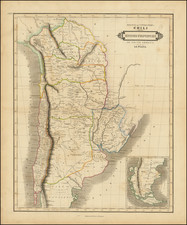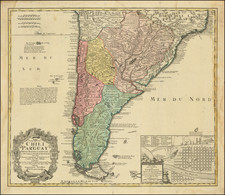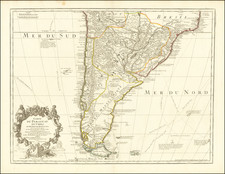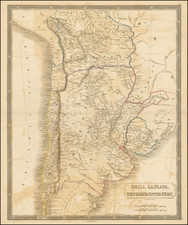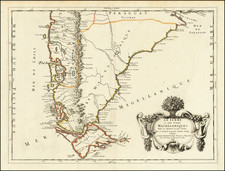A Haven For Welsh Immigrants (and other European Colonies)
A fascinating large-scale cadastral map of the National Territory of Chubut, in Southern Argentina.
This remarkably detailed map provides a granular look at the land ownership, including the lands of the different "colonial" settlers in the region, most notably the "Y Wladfa" in which Welsh-Argentines are concentrated. including the early Welsh settlements of Gaiman, Trelew and Trevelin. At the beginning of the 20th century, after the Boer War, between 1902 and 1907 a number of Boer people migrated to Chubut, settling in the Comodoro Rivadavia area.
In December 1907 the oil was discovered in the Comodoro Rivadavia area and Chubut would ultimately evolve into a major petroleum and mining center.
The map includes a plethora of inset plans along its edges. From upper-left:
- Colonia San Martin
- Colonia Sarmiento
- Ensanche Colonia Sarmiento
- Pueblo Camarones
- Pueblo Gaiman
- Pueblo Sarmineto
- Colonia Chubut
- Pueblo Comodoro Rivadavia
- Pueblo Puerto Madryn
- Pueblo Rawson Capital
- Pueblo Trelew
- Explotacion del Petroleo Distrito Fiscal y Compañias Particulares Comodoro Rivadavia [Petroleum Exploitation Fiscal District and Private Companies Comodoro Rivadavia]
The last inset documents the exploration of oil resources in the region. Though perhaps not thought of as a major oil producer, Argentina has some of the largest reserves of shale oil and gas in the world, and some of its resources were producing in the 1920s.
The map was printed by "Gmo. KRAFT Ltda., Soc. Anon. de Impresiones Generales".
The Welsh, Boer and Other Early Colonists
Y Wladfa, "The Welsh Settlement"), refers to the establishment of settlements by Welsh immigrants in Patagonia, beginning in 1865, mainly along the coast of the lower Chubut Valley. In the 19th and early 20th century the Argentine government encouraged emigration from Europe to populate Patagonia which, until the Conquest of the Desert began in the 1870s, was terra nullius, claimed but not controlled by Argentina until 1884. In 1865, Welsh people came to Chubut on the Mimosa and settled in the Chubut Valley. At the time, they were among the earliest European settlers in the region, after the Spanish missionaries of the 17th and 18th Centuries. The region was disputed between Chile and Argentina until 1881. Chile renounced its claim in order to prevent Argentina from entering into the War of the Pacific.
The idea of a Welsh colony in Patagonia originated with Michael D. Jones, a Welsh nationalist nonconformist preacher, who had called for a new "little Wales beyond Wales". Concerned that Welsh settlements in the United States quickly lost their Welsh identity, he proposed a new Wales overseas where Welsh settlers and their culture would be generally free from foreign domination and away from the influence of the English language. He recruited settlers and provided financing; Australia, New Zealand and even Palestine were considered, but Patagonia was chosen for its isolation and the Argentines' offer of 100 square miles (260 km2) of land along the Chubut River in exchange for settling the still-unconquered land of Patagonia for Argentina. A Welsh immigration committee met in Liverpool and published a handbook, Llawlyfr y Wladfa, to publicize the scheme.
On July 28 1865, the first 153 Welsh settlers arrived aboard tea clipper Mimosa. Disappointed with the land and lack of drinking water on the coast, they requested that the British Government settle them on the Falkland Islands. However, this request was ignored. Traveling to the Chubut River valley, their first settlement was a small fortress on the site which later became the town of Rawson (now the Capital of Chabut Province), which was called Yr Hen Amddiffynfa ('The Old Fortress').
The settlers, led by Aaron and Rachael Jenkins, soon established Argentina's first irrigation system based on the Chubut River, creating fertile wheatlands.[citation needed] By 1885, wheat production had reached 6,000 tons, with wheat produced by the colony winning the gold medal at international expositions at Paris and Chicago. Because the river was not navigable for large trade, the colonists decided that a railway was required to connect the Lower Chubut valley to the coast. In 1884 the Argentine Congress authorized the construction of the Central Chubut Railway by Lewis Jones y Cía. Work on the railway began in 1886, helped by the arrival of another 465 Welsh settlers on the steamer Vesta. The town that grew at the railhead was named Trelew (Town of Llew)The town grew rapidly and in 1888 became the headquarters of the Compañía Mercantil del Chubut (Chubut Trading Company). Initially the settlers were largely self-governing, with all men and women of 18 years of age or over having the right to vote.
By the mid-1880s most of the good agricultural land in the Lower Chubut valley had been claimed, and the colonists mounted a number of expeditions to explore other parts of Patagonia to seek more cultivable land. In 1885, the Welsh asked the governor of Chubut Province, Luis Jorge Fontana, for permission to arrange an expedition to explore the Andean part of Chubut. By the end of November 1885 they had reached a fertile area which the Welsh named Cwm Hyfryd (Pleasant Valley). By 1888, this site at the foot of the Andes had become another Welsh settlement (Spanish Colonia 16 de Octubre). As the population grew here, the towns of Esquel and Trevelin were founded.
In 1893, a Welsh-language newspaper called Y Drafod (The Conversation) was founded by Lewis Jones to promote Welshness in Y Wladfa By 1902, the region had become definitively Argentina, following the resolution of the Cordillera of the Andes Boundary Case. By the end of the 19th century there were some 4,000 people of Welsh descent living in Chubut. The last substantial migration from Wales took place shortly before World War I, which put a halt to further immigration.
Immigration to the area after 1914 was mainly from Italy and other southern European countries. Welsh became a minority language. A Welsh cooperative, the Cwmni Masnachol Camwy was created on the settlers' behalf in Buenos Aires and acted as a bank with 14 branches. The cooperative society collapsed in the Great Depression of the 1930s.
In 1902, Italian immigrants in Trelew formed the "Italian Society of Mutual Aid." At the end of each of the World Wars, new contingents of Italians arrived in the region.
Between 1880 and 1914, Spanish setters also came to Chubut's urban centers. By 1914 there were approximately 3300 Spanish immigrants in the valley.
Rarity
OCLC locates a single institutional example, in the Afrikaners In Argentine Collection, at the National Library of South Africa.











![[ Alaska / Cabo San Lucas / San Blas / Chile ] Views of Headlands and Islands on the Coasts of North West and South America](https://storage.googleapis.com/raremaps/img/small/88077.jpg)
